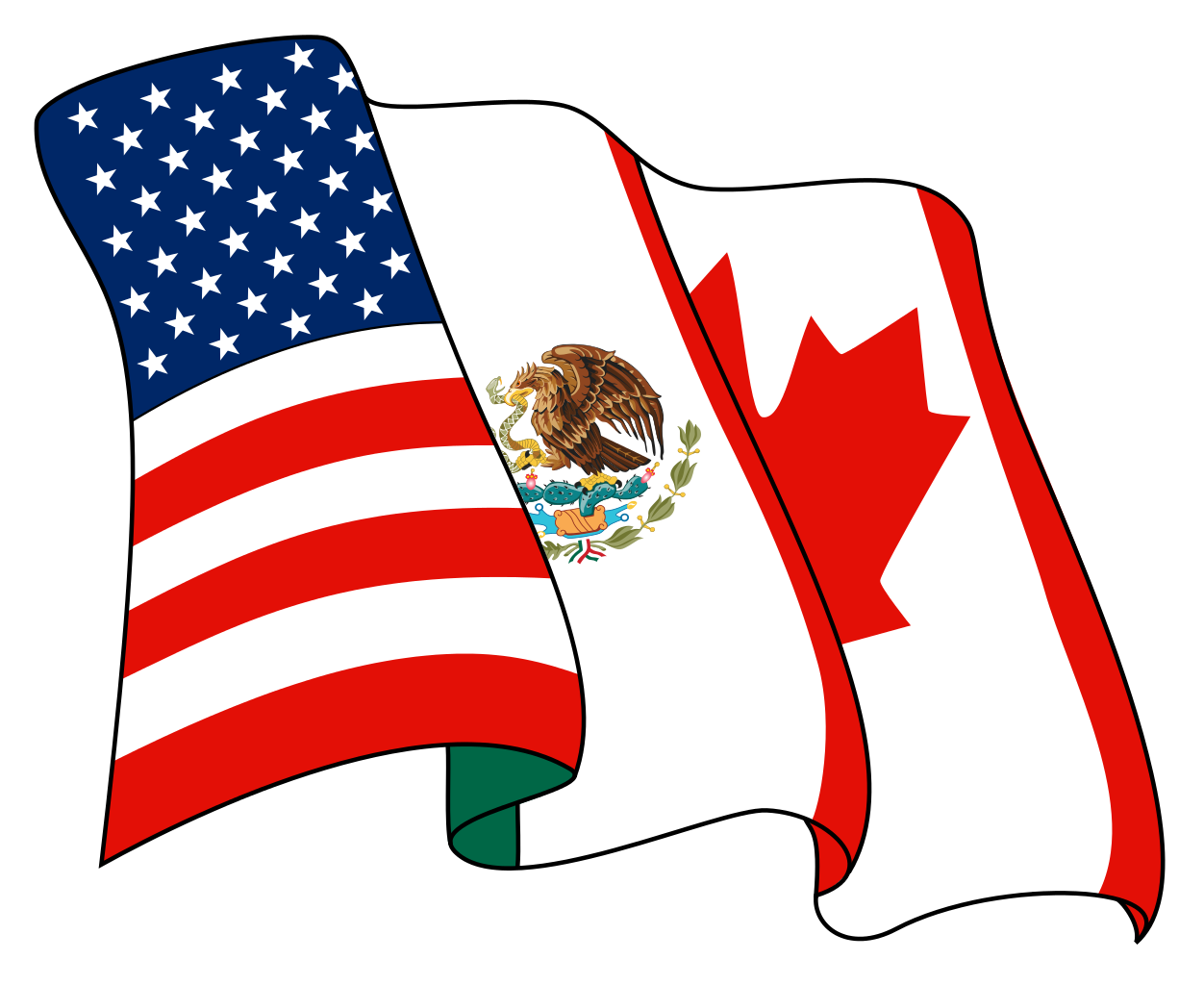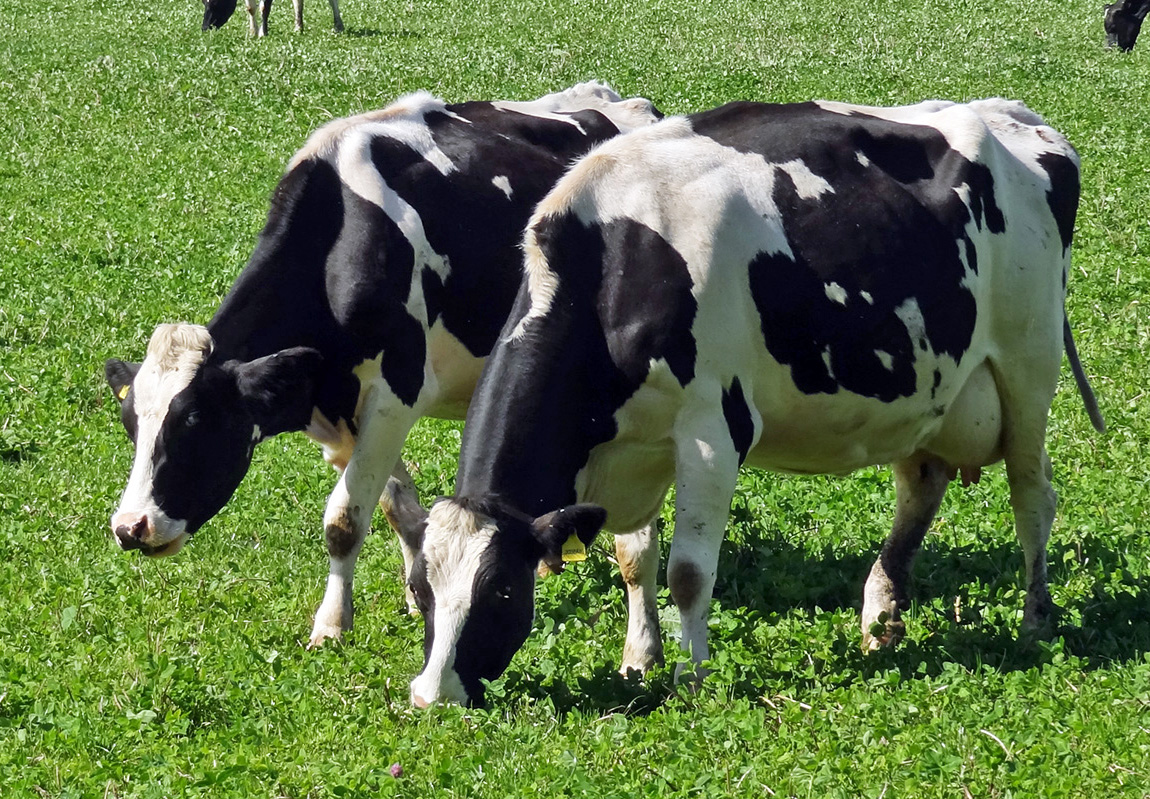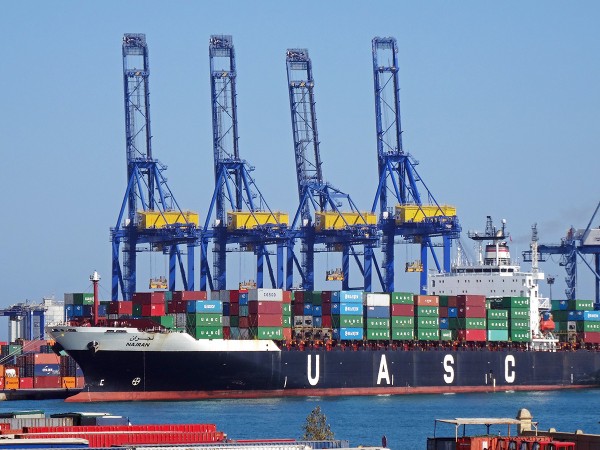 An agreement in principle was reached on September 30 between the USA, Canada and Mexico over a new trade deal to replace the North American Free Trade Agreement (NAFTA). President Trump had described NAFTA as ‘the worst trade deal maybe ever signed anywhere, but certainly ever signed in this country.’ The new deal, named the United States-Mexico-Canada Agreement, or USMCA, is the result of 14 months of negotiations, which have often been fractious. A provisional bilateral agreement was made between the USA and Mexico in August. At the same time, President Trump threatened a trade war with Canada if it did not reach a trade agreement with the USA (and Mexico). The new USMCA must be ratified by lawmakers in all three countries before it can come into force. This could take a few months.
An agreement in principle was reached on September 30 between the USA, Canada and Mexico over a new trade deal to replace the North American Free Trade Agreement (NAFTA). President Trump had described NAFTA as ‘the worst trade deal maybe ever signed anywhere, but certainly ever signed in this country.’ The new deal, named the United States-Mexico-Canada Agreement, or USMCA, is the result of 14 months of negotiations, which have often been fractious. A provisional bilateral agreement was made between the USA and Mexico in August. At the same time, President Trump threatened a trade war with Canada if it did not reach a trade agreement with the USA (and Mexico). The new USMCA must be ratified by lawmakers in all three countries before it can come into force. This could take a few months.
So is USMCA a radical departure from NAFTA? Does the USA stand to gain substantially, as President Trump claims? In fact, USMCA is little different from NAFTA. It could best be described as a relatively modest reworking of NAFTA. So what are the changes?
 The first change affects the car industry. From 2020, 75% of the components of any vehicle crossing between the USA and Canada or Mexico must be made within one or more of the three countries to qualify for tariff-free treatment. The aim is to boost production within the region. But the main change here is merely an increase in the proportion from the current 62.5%.
The first change affects the car industry. From 2020, 75% of the components of any vehicle crossing between the USA and Canada or Mexico must be made within one or more of the three countries to qualify for tariff-free treatment. The aim is to boost production within the region. But the main change here is merely an increase in the proportion from the current 62.5%.
A more significant change affecting the car industry concerns wages. Between 40% and 45% of a vehicle’s components must be made by workers earning at least US$16 per hour. This is some three times more than the average wage currently earned by Mexican car workers. Although it will benefit such workers, it will reduce Mexico’s competitive advantage and could hence lead to some diversion of production away from Mexico. Also, it could push up the price of cars.
The agreement has also strengthened various standards inadequately covered in NAFTA. According to The Conversation article:
The new agreement includes stronger protections for patents and trademarks in areas such as biotech, financial services and domain names – all of which have advanced considerably over the past quarter century. It also contains new provisions governing the expansion of digital trade and investment in innovative products and services.
Separately, negotiators agreed to update labor and environmental standards, which were not central to the 1994 accord and are now typical in modern trade agreements. Examples include enforcing a minimum wage for autoworkers, stricter environmental standards for Mexican trucks and lots of new rules on fishing to protect marine life.
 Another area where the USMCA agreement has made changes concerns trade in dairy products. This particularly affects Canada, which has agreed to allow more US dairy products tariff-free into Canada (see the CNN article at the end of the list of articles below). New higher quotas will give US dairy farmers access to 3.6% of Canada’s dairy market. They will still pay tariffs on dairy exports to Canada that exceed the quotas, ranging from 200% to 300%.
Another area where the USMCA agreement has made changes concerns trade in dairy products. This particularly affects Canada, which has agreed to allow more US dairy products tariff-free into Canada (see the CNN article at the end of the list of articles below). New higher quotas will give US dairy farmers access to 3.6% of Canada’s dairy market. They will still pay tariffs on dairy exports to Canada that exceed the quotas, ranging from 200% to 300%.
The other significant change for consumers in Mexico and Canada is a rise in the value of duty-free imports they can bring in from the USA, including online transactions. As the first BBC article listed below states:
The new agreement raises duty-free shopping limits to $100 to enter Mexico and C$150 ($115) to enter Canada without facing import duties – well above the $50 previously allowed in Mexico and C$20 permitted by Canada. That’s good news for online shoppers in Mexico and Canada – as well as shipping firms and e-commerce companies, especially giants like Amazon.
Despite these changes, USMCA is very similar to NAFTA. It is still a preferential trade deal between the three countries, but certainly not a completely free trade deal – but nor was NAFTA.
And for the time being, US tariffs on Mexican and Canadian steel and aluminium imports remain in place. Perhaps, with the conclusion of the USMCA agreement, the Trump administration will now, as promised, consider lifting these tariffs.
Video
Articles
- USMCA, the new trade deal between the US, Canada, and Mexico, explained
Vox, Jen Kirby (2/10/18)
- USMCA: What Donald Trump’s Nafta replacement trade deal means and how it will work
Independent, Mythili Sampathkumar (2/10/18)
- USMCA trade deal: Who gets what from ‘new Nafta’?
BBC News, Jessica Murphy & Natalie Sherman (1/10/18)
- Can Trump really cut the US trade deficit?
BBC News, Andrew Walker (2/10/18)
- How is ‘new NAFTA’ different? A trade expert explains
The Conversation, Amanda M. Countryman (2/10/18)
- Was NAFTA ‘worst trade deal ever’? Few agree
PolitiFact, Jon Greenberg (29/9/18)
- NAFTA out, USMCA in: What’s in the Canada, Mexico, US trade deal?
Aljazeera, Heather Gies (2/10/18)
- Mexico boosted by US-Canada agreement on revamped Nafta deal
Financial Times, Jude Webber (3/10/18)
- Nafta Is Dead. Long Live Nafta.
Bloomberg (2/10/18)
- Trump Clears Deck for China Trade War With New Nafta Deal
Bloomberg, Rich Miller, Andrew Mayeda and Jenny Leonard (2/10/18)
- Fact check: Is Trump right that the new trade deal is “biggest” ever?
CBS News (2/10/18)
- Commentary: What Trump’s new trade pact signals about China
Reuters, Andres Martinez (4/10/18)
- Canada opened its dairy market. But by how much?
CNN, Katie Lobosco (2/10/18)
Questions
- What have been the chief gains and losses for the USA from USMCA?
- What have been the chief gains and losses for Mexico from USMCA?
- What have been the chief gains and losses for Canada from USMCA?
- What are the economic gains from free trade?
- Why might a group of countries prefer a preferential trade deal with various restrictions on trade rather than a completely free trade deal between them?
- Distinguish between trade creation and trade diversion.
- In what areas, if any, might USMCA result in trade diversion?
- If the imposition of tariffs results in a net loss from a decline in trade, why might it be in the interests of a country such as the USA to impose tariffs?
 Governments of twelve Pacific rim nations, including the USA, Canada, Japan and Australia have just agreed to a trade deal – the Trans-Pacific Partnership (TPP). This represents the most significant trade deal since the completion of the Uruguay Round and the creation of the World Trade Organisation in 1994. Together these countries account for some 40% of global GDP. The deal must still be signed by the leaders of the TPP countries, however, and, more importantly, ratified by their legislatures, where, to put it mildly, agreement is not universal.
Governments of twelve Pacific rim nations, including the USA, Canada, Japan and Australia have just agreed to a trade deal – the Trans-Pacific Partnership (TPP). This represents the most significant trade deal since the completion of the Uruguay Round and the creation of the World Trade Organisation in 1994. Together these countries account for some 40% of global GDP. The deal must still be signed by the leaders of the TPP countries, however, and, more importantly, ratified by their legislatures, where, to put it mildly, agreement is not universal.
The deal is hailed as a move towards freer trade in a number of areas, including agriculture and services. But it also provides greater protection for owners of intellectual property. Proponents of the deal argue that it will to lead large-scale reductions in tariffs and other trade restrictions. As the Economist article states:
For American exporters alone, 18,000 individual tariffs will be reduced to zero. Much the same will be true for firms in the other 11 members. Even agricultural barriers, usually among the most heavily defended, will start to come down. Foreigners will gain a toehold in Canada’s dairy sector and a bigger share of Japan’s beef market, for example.
But despite this being the biggest trade deal for some 20 years, it has been highly criticised by various groups. Freer trade threatens industries that will face competition from other countries in the TPP. This unites both corporations and unions in trying to protect their own specific interests. However, the agreement gives ground to many special industries by retaining protection in a number of areas, at least for several years.
 It has also been criticised by environmentalists who worry about the removal of various environmental safeguards. In answer to these concerns, there are several provisions in the agreement that provide some measure of environmental protection so as to slow things such as deforestation, overfishing and carbon emissions. But environmentalists argue that these provisions do not go far enough.
It has also been criticised by environmentalists who worry about the removal of various environmental safeguards. In answer to these concerns, there are several provisions in the agreement that provide some measure of environmental protection so as to slow things such as deforestation, overfishing and carbon emissions. But environmentalists argue that these provisions do not go far enough.
Others are concerned that the agreement will allow corporations to challenge governments and undermine the ability of governments to regulate them.
The articles look at some of the details of the agreement and at the arguments for and against ratifying it. Some of these arguments go to the heart of the age-old free trade versus protection debate.
US, Japan and 10 countries strike Pacific trade deal Financial Times, Shawn Donnan and Demetri Sevastopulo (5/10/15)
What Trade-Deal Critics Are Missing Wall Street Journal, Zachary Karabell (8/10/15)
The Trans-Pacific Partnership: Weighing anchor The Economist (10/10/15)
A trade deal is no excuse to milk taxpayers Globe and Mail (Canada), Yuen Pau Woo (7/10/15)
What Is the Trans-Pacific Partnership Agreement (TPP)? Electronic Frontier Foundation
Wikileaks release of TPP deal text stokes ‘freedom of expression’ fears The Guardian, Sam Thielman (9/10/15)
TPP’s clauses that let Australia be sued are weapons of legal destruction, says lawyer The Guardian, Jess Hill (10/11/15)
Questions
- Who are likely to benefit from the TPP?
- Why are American republicans generally opposed to the agreement?
- What are the objections to the TPP’s provisions for the protection of intellectual property rights?
- Would the current twelve members of the TPP gain if China joined?
- What are the objections of environmentalists to TPP?
- What effect will the TPP on European countries?
- Other than a reduction in tariffs, what other types of measures are included in the TPP?
- What is the Investor-State Dispute Settlement mechanism and what criticisms have been made of it? Are they justified?
The east African countries of Kenya, Tanzania, Uganda, Burundi and Rwanda have been operating with a common external tariff for some time. The East African Community (EAC), as it is known, came into force in 2000. Initially it had just three members, Kenya, Tanzania and Uganda; the other two countries joined in 2007. As the Community’s site says:
The EAC aims at widening and deepening co-operation among the Partner States in, among others, political, economic and social fields for their mutual benefit. To this extent the EAC countries established a Customs Union in 2005 and are working towards the establishment of a Common Market in 2010, subsequently a Monetary Union by 2012 and ultimately a Political Federation of the East African States.
This Common Market came into force on 1 July 2010, with free movement of labour being instituted between the five countries. The plan is also to do away with all internal barriers to trade, although it may take up to five years before this is completed.
The following articles and videos look at this significant opening up of trade in east Africa and at people’s reactions to it. Will all five countries gain equally? Or will some gain at the others’ expense?
Articles
East African Countries Form a Common Market New York Times, Josh Kron (1/7/10)
Dawn of an era for East Africans The Standard, John Oyuke (1/7/10)
5 East African countries create common market The Associated Press, Tom Maliti (1/7/10)
FACTBOX-East African common market begins Reuters (1/7/10)
Bold plan to have single EAC currency by 2012 Daily Nation, Lucas Barasa (1/7/10)
East Africa’s common market begins BBC News, Tim Bowler (30/6/10)
East Africa: Poor Road, Railway Network Holding Back Integration allAfrica.com, Zephania Ubwani (1/7/10)
Challenges for one East Africa Common Market The Sunday Citizen, James Shikwati (4/7/10)
Videos
 Common market barriers NTVKenya (on YouTube) (2/7/10)
Common market barriers NTVKenya (on YouTube) (2/7/10)
 The fruits of E.A.C. NTVKenya (on YouTube) (2/7/10)
The fruits of E.A.C. NTVKenya (on YouTube) (2/7/10)
The East African Community (EAC)
Official site
Wikipedia entry
Questions
- Distinguish between a free trade area, a customs union, a common market and a monetary union.
- How is it possible that all five countries will gain from the establishment of a common market?
- Distinguish between trade creation and trade diversion. Under what circumstances is the establishment of a common market more likely to lead to (a) trade creation; (b) trade diversion?
- Why do some people worry about the consequences of free movement of labour with the EAC? How would you answer their concerns?
- What factors would need to be taken into account in deciding whether or not the five countries would benefit from forming a monetary union?
 An agreement in principle was reached on September 30 between the USA, Canada and Mexico over a new trade deal to replace the North American Free Trade Agreement (NAFTA). President Trump had described NAFTA as ‘the worst trade deal maybe ever signed anywhere, but certainly ever signed in this country.’ The new deal, named the United States-Mexico-Canada Agreement, or USMCA, is the result of 14 months of negotiations, which have often been fractious. A provisional bilateral agreement was made between the USA and Mexico in August. At the same time, President Trump threatened a trade war with Canada if it did not reach a trade agreement with the USA (and Mexico). The new USMCA must be ratified by lawmakers in all three countries before it can come into force. This could take a few months.
An agreement in principle was reached on September 30 between the USA, Canada and Mexico over a new trade deal to replace the North American Free Trade Agreement (NAFTA). President Trump had described NAFTA as ‘the worst trade deal maybe ever signed anywhere, but certainly ever signed in this country.’ The new deal, named the United States-Mexico-Canada Agreement, or USMCA, is the result of 14 months of negotiations, which have often been fractious. A provisional bilateral agreement was made between the USA and Mexico in August. At the same time, President Trump threatened a trade war with Canada if it did not reach a trade agreement with the USA (and Mexico). The new USMCA must be ratified by lawmakers in all three countries before it can come into force. This could take a few months. The first change affects the car industry. From 2020, 75% of the components of any vehicle crossing between the USA and Canada or Mexico must be made within one or more of the three countries to qualify for tariff-free treatment. The aim is to boost production within the region. But the main change here is merely an increase in the proportion from the current 62.5%.
The first change affects the car industry. From 2020, 75% of the components of any vehicle crossing between the USA and Canada or Mexico must be made within one or more of the three countries to qualify for tariff-free treatment. The aim is to boost production within the region. But the main change here is merely an increase in the proportion from the current 62.5%. Another area where the USMCA agreement has made changes concerns trade in dairy products. This particularly affects Canada, which has agreed to allow more US dairy products tariff-free into Canada (see the CNN article at the end of the list of articles below). New higher quotas will give US dairy farmers access to 3.6% of Canada’s dairy market. They will still pay tariffs on dairy exports to Canada that exceed the quotas, ranging from 200% to 300%.
Another area where the USMCA agreement has made changes concerns trade in dairy products. This particularly affects Canada, which has agreed to allow more US dairy products tariff-free into Canada (see the CNN article at the end of the list of articles below). New higher quotas will give US dairy farmers access to 3.6% of Canada’s dairy market. They will still pay tariffs on dairy exports to Canada that exceed the quotas, ranging from 200% to 300%. New NAFTA deal
New NAFTA deal
